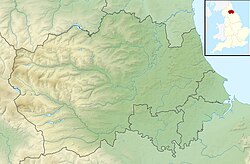| Wingate Quarry | |
|---|---|
| Location | MAGiC MaP |
| Nearest town | Ferryhill, County Durham Peterlee, County Durham |
| Coordinates | 54°43′54″N1°25′17″W / 54.73167°N 1.42139°W |
| Area | 23.35 ha (57.7 acres) |
| Established | 1984 |
| Governing body | Natural England |
| Website | Wingate Quarry |
Wingate Quarry is a biological Site of Special Scientific Interest in the County Durham district of east County Durham, England. [1] Part of the site is also a Local Nature Reserve [2] It is a disused quarry located just south of the village of Wheatley Hill.

The quarry was worked for Magnesian Limestone until the 1930s, when it closed. Since then a large and varied grassland has developed on the site. Magnesian limestone grassland is nationally scarce, with this site accounting for close to 8 per cent of the national total. As well as species that are characteristic of this vegetation type, there are also two orchids, fragrant orchid, Gymnadenia conopsea , and frog orchid, Coeloglossum viride , both of which are uncommon in County Durham. [1]
